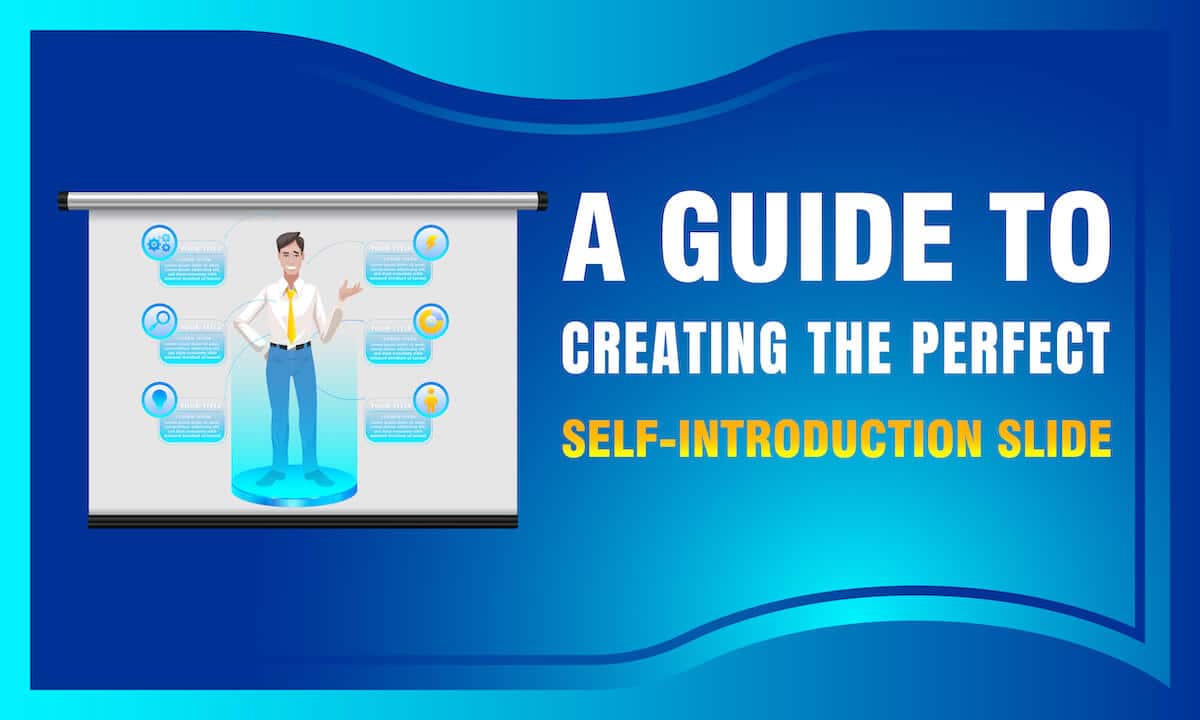Imagine that you need to deliver a presentation to an audience you’ve never seen before. This could include people from diverse backgrounds, such as experts as well as amateurs. You step on the stage and feel blue as these viewers look completely blank because they have no idea of who you are. Thus, the first thing that you need to do is acquaint them with you and explain what brings you here. Even though this sounds simple, the question is, how can you introduce yourself in a manner that would mesmerize the audience and leave a positive impact on them?
Well, a solution to this is commencing your presentations with self-introduction slides. These slides talk about your background, experience, and qualifications and inform the audience with all necessary details. In today’s digital age, these slides have become an essential tool for personal branding, networking, and professional presentations. Whether you’re a student, job seeker, entrepreneur, or public speaker, a good self-introduction slide can open doors of opportunities for you.
However, creating these slides perfectly can be quite nerve-racking. If not done properly, it can give you cold feet. Thus, this article is a complete guide on how to design and deliver compelling self-introductions with examples to inspire and guide you through the process.
Understanding the Purpose of a Self-Introduction Slide
Before embarking on the design process, it is crucial to understand the purpose of your slide. It will largely depend on the context in which you plan to utilize it, whether a job interview, a networking event, or a webinar. This way, you can effectively structure and tailor the content to your audience’s needs.
For instance, while creating a self-introduction slide for a job interview, your objective would be to showcase your educational qualifications, skills, and experiences concisely and impactfully. Here, the focus will be on proving how you would be a good fit for the job and highlighting the values you could bring to the organization.
However, if you are a team lead and preparing slides for a team briefing, the purpose and content will differ from a job interview. In this case, the key aim is to provide an overview of your work profile, expertise, and previous accomplishments as a leader.
Let us take you through various tips and tricks that will enable you to make stunning slides.
The Design
Giving your presentation a stunning visual appearance seems like a piece of cake, isn’t it? But right after you create your first slide, your mind goes through all these unfathomable questions, such as, is the slide too cluttered, or is it neat and tidy? Do the fonts match the background? Are the visuals too distracting, or do they blend well with each other?
Thus, here are some design tips that will help you answer such questions and allow you to create stunning slides.
1. Keep it Simple and Minimal
Simplicity and professionalism should be your guiding principles when designing a self-introduction slide. A clean and minimalistic layout helps create a sense of space and clarity. It gives the audience a proper perspective of who you are and restricts them from getting overwhelmed with excess information.
Remove any unnecessary visuals and text, as they may distract the audience and make them uninterested. Instead, pick a background with a solid or light-textured hue, avoid flashy animations and graphics, and refrain from adding too many elements onto a single slide.
This will ensure that your design exudes professionalism and conveys a sense of organization and attention to detail. It will also enhance readability and comprehension.
For instance, let us look at this slide which is set in a neutral tone with no clutter and is exceptionally tidy and organized. The moment you watch it, it reflects clarity and coherence.
2. Focus on Fonts – Clarity, Pairing, and Size
Fonts can create all the difference in design- they can make and even break your presentations. Thus, it is necessary to choose lucid and easy-to-read typographies. They should be clear, even for the audience sitting at the back.
While picking fonts, make sure not to select the ones with intricate details and overly decorated, as they may be inaccessible and inconvenient. Instead, choose designs that are evenly spaced and neatly arranged.
It is also important to pay heed to the size and hierarchy of fonts to create a flawless slide- make your headings the largest, followed by subheadings, paragraphs, etc. This way, you can guide your audience through multiple steps with the help of font hierarchy.
Another crucial factor is to ensure that all your texts pair well with each other and come together properly. This can be done by picking fonts from similar families, as when they are put together, they uplift the look of the slide and notch up the presentation. Let us understand with the example below, where multiple texts are structured in fonts of the same family and blend perfectly well with each other.
3. Maintain Consistency with a Brand Palette
One of the most crucial elements of a successful presentation is its brand palette and slide consistency. When it comes to introducing yourself, you must focus on incorporating your personal or organization’s style into your slides.
You can do this by selecting a color palette that aligns with your brand or the occasion. Use these hues consistently throughout the slide, including for text, backgrounds, and graphical elements. Consistent color choices not only create visual harmony but also reinforce the intended tone of your presentation.
When your self-introduction slide is consistent in its use of tints, fonts, and visual elements, it creates a cohesive and unified impression. This consistency helps the audience associate your personal brand or the presentation’s theme with the visuals they see, making it more memorable and impactful.
Let us understand with the help of an example. In the visual below, being a creative designer, you might like to use colors that pop out and seem more fun and interactive. This would resonate more with your audience and convey your style in the blink of an eye. However, there may be better options for other professionals, and thus every individual must pick their own set of colors that would cater to their needs and portray their values.
4. Use High-Quality Images and Visuals.
Visuals such as images, icons, or charts can enhance the impact of your slide and make it more appealing. When selecting visuals, it is crucial to choose high-quality images that are relevant to you and the content you are presenting.
For instance, if you are an entrepreneur in the fitness industry, consider incorporating visuals that go well with your field. You could include images of individuals engaging in healthy lifestyle activities, such as jogging, weightlifting, or practicing yoga. Additionally, including pictures of fitness equipment or healthy meals can further reinforce your expertise and passion for the industry.
Furthermore, icons or infographics can be effective in conveying information in a visually engaging manner. For example, using icons to represent different skills or areas of expertise can add visual interest and help your audience grasp key points quickly.
By thoughtfully incorporating relevant visuals, you can make your self-introduction slide more captivating and make an indelible mark on your audience.
5. Use Expert-Designed Slides to Ease the Task
Crafting slides from scratch can be quite burdensome and tiring. It can sap away most of your energy and waste much of your precious time in making the presentation rather than on other important tasks.
Thus, you can harness the power of expert-designed self intro slides that come in an array of designs and variety and offer complete customization. These slides can be easily added to your existing presentation and tailored according to your needs- you can change the color, font, sizes, etc.
The Delivery
Now that you have mastered the design, it is time to focus on skillfully preparing for the delivery. It doesn’t matter if your slide looks stunning; until and unless you deliver it with sheer confidence and unwavering courage, you might lose on the impact of the presentation.
To make sure that you deliver the presentation effectively, here are some delivery tips that you can follow.
1. Start Strong: Commence with a Bold Heading
The headline of your self-introduction slide holds significant importance as it sets the tone for your presentation and gets your audience on their toes. It should be concise, engaging, and absolutely mind blowing, as this is an opportunity to showcase your unique selling point and pique curiosity about what you have to offer.
For instance, imagine you are an aspiring web developer who wants to communicate your expertise. You can begin with a headline such as “Generating Innovative Digital Experiences: Web Developer with a Passion for User-Centric Design.” This succinctly communicates your area of expertise and highlights your commitment to creating exceptional user experiences through your work.
Incorporating a tagline or a memorable phrase can further enhance your introduction and make it more impactful. Think about what sets you apart from others in your field and encapsulate it captivatingly.
Let us understand with the help of another example. Consider you are a marketing analyst and want to attract clients. You can open by saying, “Empowering Businesses with Data-Driven Insights: Marketing Analyst Driving Strategic Growth.” This emphasizes your ability to leverage data to deliver valuable insights and drive strategic growth for businesses.
When writing your headline, consider using strong, action-oriented language highlighting your key skills, experience, or unique perspective. It should resonate with your brand and align with the purpose of your self-introduction.
Remember, the headline of your self-introduction slide is your opportunity to make a compelling first impression and generate interest in your presentation. By crafting a concise, engaging, and brand-aligned headline, you can capture your audience’s attention and create anticipation for what you have to offer.
2. Be Selective with Personal Information
While it is important to create an emotional connection with the audience, make sure that you do not overshare personal information or delve deep into unnecessary details.
Keep your information short and brief- provide an overview of your personal background, including your name, current role or occupation, educational qualifications, and any other relevant information that helps establish your credibility. Talk about yourself, hobbies, linguistic skills, professional achievements, etc. Avoid sharing excessive details and focus on what is most important for your audience to know.
3. Speak with Confidence
When introducing yourself, the most important factor is to project confidence and convey a strong presence.
Make sure that you maintain a strong posture that exudes confidence and brilliance- stand tall or sit upright, keep your head held high, and do not lean or slouch. With good body language, you can appear more assertive and self-assured.
You must also speak clearly at a desired pace. Avoid rushing in or mumbling through the words, as it reflects poor stature and diminishes your value. Thus, practice enunciating words, phrases, and sentences and use proper pronunciation to convey conviction.
Conclusion
A well-designed self-introduction slide can be a powerful tool to ensure that your audience can resonate with and remember your content for a long time. By following the steps outlined in this guide and drawing inspiration from the provided examples, you can create an impactful and professional slide that effectively communicates your personal brand, skills, and achievements. Remember to tailor your content to the specific purpose and continuously refine it to reflect your evolving personal and professional journey.
Looking For Powerpoint Design Agency?
Call Pursho @ 0731-6725516
Telegram Group One Must Follow :
For Startups: https://t.me/daily_business_reads
#Guide #Creating #Perfect #SelfIntroduction #Slide




